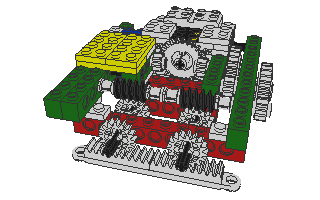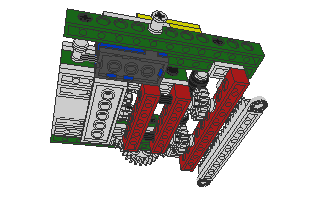Servo Motor
When building a robot that drives like a car, you will probably need a servo motor for the steering part. A servo motor is a regular DC motor with built in gearing and electronics that enables it to rotate to a certain angle and hold it. A standard R/C servo motor can be troublesome to fit into a LEGO® design and if you're going to use an RCX to control your car, then you're going to need some extra electronics to get that to work.
This creation is an attempt to mimic the behaviour of a servo motor using only official LEGO® parts and is designed for rack and pinion steering. You can build the thing with parts from the LEGO® Robotics Invention System kit except for the rotation sensor which you'll have to get separately (try Pitsco or Active Robots).
As previously mentioned, with a servo motor you have the ability to rotate it to a certain angle. This creation accomplishes this by incorporating a LEGO® rotation sensor (some call it an angle sensor) to measure how many rotations the motor has done. Since the LEGO® rotation sensors are quadrature encoders they can tell which way they are rotating - otherwise they'd be pretty useless in this design. The rotation sensors can be used for up to around 500 RPM and if you look closely you'll notice that I geared the connection from the motor to the rotation sensor with a ratio of 1:3 which is only good if the motor does a max of about 165 RPM. Otherwise the rotation sensor will skip counts which in turn will lead to displacing the rack. If your motor exceeds 165 RPM you should attach the rotation sensor another place (e.g. on the opposite side on an axle with an 8-tooth gear meshing with the 24-tooth gear closest to the motor). Watching the rotation sensor and deciding whether to stop or start the motor and which direction it should turn is the job of the software running on the controller.
The ability for a servo motor to hold its rotation angle is mimiced by using two worm screws to control rack displacement. Worm screws have the nice ability that they can rotate gears that mesh correctly with them but the gears cannot rotate the worm screw due to the perpendicular setup. Thus no electrical power is needed to hold this servo motor in place.

